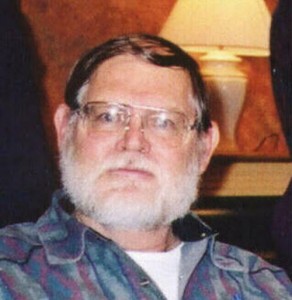
March 31, 2012

Ten year ago, LeRoy Fish, 59, passed away.
According to his wife, Jacqueline, Dr. Fish went out to his Blachly, Oregon, home’s barn to do some chores on the morning of Wednesday, 20 March 2002. She found him soon thereafter, having died of congestive heart failure.
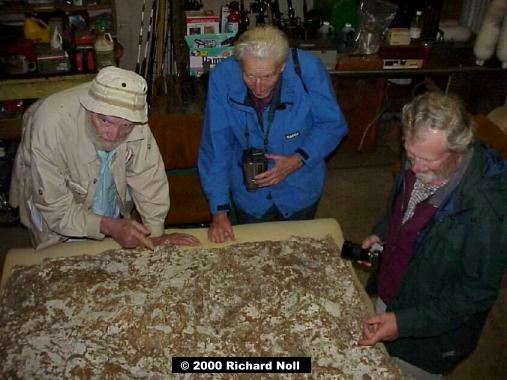
Fish was one of the primary scientific consultants who examined the so-called Skookum “body cast” (shown above) – said to have been made by a Sasquatch. In 2000, Richard Noll and twelve other individuals on an expedition looking for evidence of Bigfoot made this remarkable find near Skookum Meadow, in Washington.
The cast was specifically taken on September 22, 2000, during a Bigfoot Field Researchers Organization (BFRO) expedition to the Skookum Meadows area of the Gifford Pinchot National Forest in southern Washington State, during filming of the now-cancelled Animal-X television show.
The cast, which measures 3.5 by 5 feet (1.1 × 1.5 m) and weighs approximately 400 pounds (180 kg), is of a partial body imprint left in roadside mud. Impressions of hair are evident on the cast. The body dimensions of the cast are reportedly 40 to 50 percent larger than that of a six-foot tall human. On the same expedition of the BFRO there was evidence of 17 inch footprints that may have belonged to a Sasquatch as well. Many individuals, including a former curator of the BFRO, Ron Schaffner, recognized several anatomical features that led them to conclude it was made by a resting elk. The cast apparently reveals landmarks that can be recognized as the hindlegs, hip, chest, and wrists of a reclining elk. Cleaning the cast revealed finer details, including “extensive impressions of hair on the buttock and thigh surfaces”, and what appears to be longer hair along the forearm. Alternatively, it has been said by some Bigfoot enthusiasts to show the imprint of a forearm, hip, thigh, heel and ankle, and Achilles tendon of a reclining Sasquatch. Impressions of hair are evident on the buttocks and thigh surfaces of the cast, as well as much longer fringes of hair on the forearm region. Dermal ridges appear on the heel, with many of the same characteristics consistently found on other purported Sasquatch samples. Dermal ridges have been alleged to occur on a “heel,” but these have been interpreted as hair impressions from the wrist of an elk. A number of elk hoof imprints and coyote paw prints are also present.
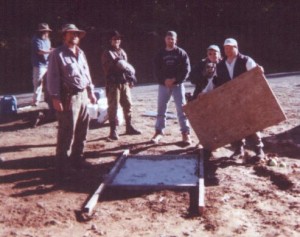
Skookum expedition participants, from left to right, Rick Noll, Greg Bambanek, Ian (one of the Aussie film crew), Alan Terry (center), Erin (Jeff’s girlfriend), and Jeff Lemley (holding board). Bottom center between the 2×4’s, is the cast, partially completed, with first (splash) layer in place. Photo credit: Thom Powell.
Elk hair and bear hair were found in the cast. Henner Fahrenbach, a retired biomedical researcher from Beaverton, Oregon, analyzed some hairs and claims to have identified a single specimen, which he believes belongs to a Sasquatch, although he admits this identification is very tentative and impossible to test.
There are multiple interpretations as to what the cast represents. Impressions of the elk’s wrists were studied by anthropologist Jeff Meldrum, Ph. D. of Idaho State University, and his interpretation of their anatomy matches his hypothetical models of a Sasquatch foot. Others note a much stronger similarity between the imprints and an elk’s wrist and metacarpal impression. This perspective received support through the lack of “Bigfoot footprints” in the immediate vicinity.
The cast has been examined by several Sasquatch enthusiasts, including journalist John Green, John Bindernagel, and Meldrum, who believe the cast to be authentic, and solid evidence of the existence of Sasquatch. The late anthropologist Grover Krantz went on record as saying that he had no idea what the cast represented. Ron Schaffner, formerly linked to the BFRO, and others within the group, recognized several unique characteristics of an ungulate lay, indicating to them the imprint was made by an elk.
On March 3, 2001, Marc Hume wrote an article for the National Post of Canada in which he recognized the clear tracks of an elk and described: “imprints left that would match perfectly with an elk’s legs.” In his opinion, the cast was “if anything, a cast of the impression made by the hindquarters of an elk.”
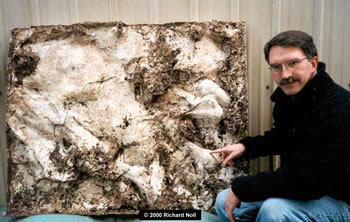
LeRoy Fish, a retired wildlife ecologist, had been a consultant to the Bigfoot Field Researchers Organization on the Skookum cast and other matters. He received his bachelor’s and master’s degrees from Walla Walla College, and his doctorate in Zoology/Ecology from Washington State University. Dr. Fish had over 30 years experience in wildlife research.
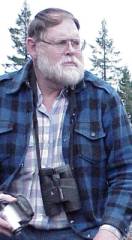
Fish was born 10 February1943, in Portland, Oregon, was raised in Eugene, and then married Jacqueline Fischer in Woodland, Washington, on 7 October 1983, moving to Blachy three years later. He is survived by his wife, three daughters, a brother, a sister, and three grandchildren.
His was a sad loss for the Bigfoot research world.
About Loren Coleman
Loren Coleman is one of the world’s leading cryptozoologists, some say “the” leading living cryptozoologist. Certainly, he is acknowledged as the current living American researcher and writer who has most popularized cryptozoology in the late 20th and early 21st centuries.
Starting his fieldwork and investigations in 1960, after traveling and trekking extensively in pursuit of cryptozoological mysteries, Coleman began writing to share his experiences in 1969. An honorary member of Ivan T. Sanderson’s Society for the Investigation of the Unexplained in the 1970s, Coleman has been bestowed with similar honorary memberships of the North Idaho College Cryptozoology Club in 1983, and in subsequent years, that of the British Columbia Scientific Cryptozoology Club, CryptoSafari International, and other international organizations. He was also a Life Member and Benefactor of the International Society of Cryptozoology (now-defunct).
Loren Coleman’s daily blog, as a member of the Cryptomundo Team, served as an ongoing avenue of communication for the ever-growing body of cryptozoo news from 2005 through 2013. He returned as an infrequent contributor beginning Halloween week of 2015.
Coleman is the founder in 2003, and current director of the International Cryptozoology Museum in Portland, Maine.
Filed under Bigfoot, Cryptomundo Exclusive, CryptoZoo News, Footprint Evidence, Forensic Science, Men in Cryptozoology, Obituaries, Sasquatch